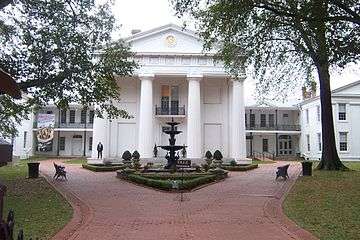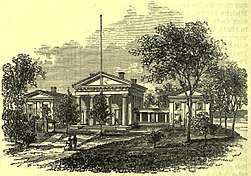Old State House Museum (Little Rock, Arkansas)
|
Old State House Museum | |
 South façade of the Old State House Museum | |
 Location within Arkansas | |
| Location |
300 W. Markham St., Little Rock, Arkansas |
|---|---|
| Coordinates | 34°44′56.3″N 92°16′19.42″W / 34.748972°N 92.2720611°WCoordinates: 34°44′56.3″N 92°16′19.42″W / 34.748972°N 92.2720611°W |
| Area | less than one acre |
| Built | 1842 |
| Architect |
Gideon Shryock George Weigart |
| Architectural style | American neoclassicism |
| Website |
oldstatehouse |
| NRHP reference # | 69000037 |
| Significant dates | |
| Added to NRHP | December 03, 1969[1] |
| Designated NHL | December 9, 1997[2] |
The Old State House Museum, formerly called the Arkansas State House, is the oldest surviving capitol building west of the Mississippi River. It was the site of the 1861 secession debate, as well as the 1868 Constitutional Convention when delegates agreed to ensure voting rights for freedmen and establish public schools.
History
Construction
Commissioned by Governor John Pope, the State House was constructed between 1836 and 1842. Architect Gideon Shryock, who previously designed the Kentucky State Capitol in Frankfort, chose a Greek Revival style for the building. The original design was too expensive for the territory, so Shryock's assistant George Weigart changed the plans and oversaw construction. The Arkansas General Assembly moved into the building while construction was ongoing. On December 4, 1837, in the first session of the General Assembly, Speaker John Wilson killed Representative Joseph J. Anthony in a knife fight on the floor of the state House of Representatives.
American Civil War
Unionists prevailed at an initial, March 1861, secession convention after the 1860 election of Abraham Lincoln. However, after South Carolina fired on Fort Sumter and Lincoln called up troops, on the morning of May 6, 1861, a second secession convention assembled at the State House. After intense debate, an ordinance of secession passed with five opposing votes. Four opposing delegates relented after unanimity was urged. Isaac Murphy, a delegate from Madison County, held out despite enormous pressure. After the Union victory at the Battle of Bayou Fourche in September 1863, Federal troops occupied the building for the rest of the war.
Reconstruction Era

After the American Civil War ended, the State House was the site of another constitutional convention to determine whether Arkansas would accept the Fourteenth Amendment to the U.S. Constitution, permit suffrage for black males over 21, and create public schools for both black and white children. After contentious debate, the proposals were approved in a new constitution that emerged in February 1868, and was ratified in March. Also during Reconstruction, the State House was an object of contention in the so-called Brooks–Baxter War, and was fortified during that struggle. The cannon "Lady Baxter" still remains on the State House grounds.
Changing use
The building served as a state capitol until the new capitol building was constructed in 1912. For a time it was used as a medical school. Afterwards, it served as an Arkansas war memorial and was used as an office building for federal and state agencies, as well as a meeting place for patriotic organizations. In 1947 the General Assembly approved acts designating the State House as a museum. The front entrance was the site of President Bill Clinton's presidential campaign announcement and the site of his election night celebrations in both of his campaigns for the presidency.[3] The building underwent major renovation in 1996, and it was designated a National Historic Landmark in 1997.[2][4] The building continues to serve as a museum with exhibits related to Arkansas history and culture. Permanent collections include battle flags, the inaugural gowns of the First Ladies of Arkansas, art pottery, and African-American quilts. Special exhibits are staged periodically as well.
See also
References
- ↑ National Park Service (2007-01-23). "National Register Information System". National Register of Historic Places. National Park Service.
- 1 2 "Old State House, Little Rock". National Historic Landmark summary listing. National Park Service. 2007-09-26.
- ↑ "Old State House Museum - Arkansas Old State House - Arkansas State House Museum". Retrieved 30 December 2016.
- ↑ Cynthia DeHaven Pitcock (July 29, 1997). "National Historic Landmark Nomination: Old State House" (PDF). National Park Service. Retrieved 2009-06-22 and Accompanying 42 photos, exterior and interior, from 1996-1997 (7.95 MB)
Further reading
- Historic American Buildings Survey (HABS) No. AR-32-1, "Old State Capitol Building, Markham & Center Streets, Little Rock, Pulaski County, AR"
- O'Donnell, William W. (1987). "Prelude to The Civil War Quadrennium". The Civil War Quadrennium: A Narrative History of Day-to-Day Life in Little Rock, Arkansas During the American War Between Northern and Southern States 1861-1865 (2nd ed.). Little Rock, Ark.: Civil War Round Table of Arkansas. pp. 1–14. LCCN 85-72643 – via Horton Brothers Printing Company.
External links
- Government
- General information